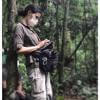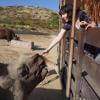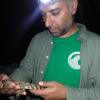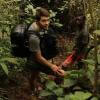Camera traps have been a key part of the conservation toolkit for decades. Remotely triggered video or still cameras allow researchers and managers to monitor cryptic species, survey populations, and support enforcement responses by documenting illegal activities. Increasingly, machine learning is being implemented to automate the processing of data generated by camera traps.
A recent study published showed that, despite being well-established and widely used tools in conservation, progress in the development of camera traps has plateaued since the emergence of the modern model in the mid-2000s, leaving users struggling with many of the same issues they faced a decade ago. That manufacturer ratings have not improved over time, despite technological advancements, demonstrates the need for a new generation of innovative conservation camera traps. Join this group and explore existing efforts, established needs, and what next-generation camera traps might look like - including the integration of AI for data processing through initiatives like Wildlife Insights and Wild Me.
Group Highlights:
Our past Tech Tutors seasons featured multiple episodes for experienced and new camera trappers. How Do I Repair My Camera Traps? featured WILDLABS members Laure Joanny, Alistair Stewart, and Rob Appleby and featured many troubleshooting and DIY resources for common issues.
For camera trap users looking to incorporate machine learning into the data analysis process, Sara Beery's How do I get started using machine learning for my camera traps? is an incredible resource discussing the user-friendly tool MegaDetector.
And for those who are new to camera trapping, Marcella Kelly's How do I choose the right camera trap(s) based on interests, goals, and species? will help you make important decisions based on factors like species, environment, power, durability, and more.
Finally, for an in-depth conversation on camera trap hardware and software, check out the Camera Traps Virtual Meetup featuring Sara Beery, Roland Kays, and Sam Seccombe.
And while you're here, be sure to stop by the camera trap community's collaborative troubleshooting data bank, where we're compiling common problems with the goal of creating a consistent place to exchange tips and tricks!
Header photo: ACEAA-Conservacion Amazonica
- @kaitlyngaynor
- | she/her, they/them
- 0 Resources
- 0 Discussions
- 3 Groups
- @KC
- | She/her
Graduate Research Assistant at SDSU, Conservation officer for Department of Forest and Park Services, Bhutan. Works on carnivores, applied quantitative ecologist
- 0 Resources
- 0 Discussions
- 7 Groups
Project planet is working to mitigate conflict between farmers and forest elephants in Gabon, Central Africa.
- 0 Resources
- 0 Discussions
- 3 Groups
I am a field researcher working with camera traps and thermal imaging to better understand rainforest mammals.
- 0 Resources
- 8 Discussions
- 1 Groups
Wild Me



- 1 Resources
- 20 Discussions
- 6 Groups

- 0 Resources
- 0 Discussions
- 5 Groups
PhD student using Geo-AI and remote sensing to address environmental problems
- 0 Resources
- 0 Discussions
- 2 Groups
- @eliminatha
- | she
Passionate wildlife researcher dedicated to uncovering the secrets of the natural world via the lens of camera traps. With a sharp eye for detail and a strong commitment to wildlife conservation.
- 0 Resources
- 0 Discussions
- 4 Groups
Wildlife conservationist
- 0 Resources
- 0 Discussions
- 11 Groups
- @Amitkaushik
- | he/him/his
University of Georgia (UGA)
Environmental anthropologist; An interdisciplinary Ph.D. student, bridging conservation science, policies, and social justice
- 0 Resources
- 1 Discussions
- 2 Groups
Data has been my passion and i enjoy working with data while bringing value to the business. Data engineer with 7+ years of experience Eager to support with expert analytical skills to advance the companys business operations and strategic initiative.
- 0 Resources
- 0 Discussions
- 9 Groups
- @kbubnicki
- | he/his
Ecologist, data scientist, and programmer with over 13 years of professional experience. Open source and Linux enthusiast. Researcher at the Mammal Research Institute, Polish Academy of Sciences, and CEO of the Open Science Conservation Fund.
- 0 Resources
- 0 Discussions
- 5 Groups
Article
Read in detail about how to use The Inventory, our new living directory of conservation technology tools, organisations, and R&D projects.
1 May 2024
Article
The Inventory is your one-stop shop for conservation technology tools, organisations, and R&D projects. Start contributing to it now!
1 May 2024
Technology to End the Sixth Mass Extinction. Salary: $132 - $160k; Location: Seattle WA; 7+ years of experience in hardware product development and manufacturing; View post for full job description
1 May 2024
The incumbent will develop models and metrics that can be used to shape conservation policy using multiple data sources including camera traps, movement data and citizen science concerning the diversity and...
23 April 2024
Careers
The Smithsonian National Zoo & Conservation Biology Institute is seeking a Program Manager to help coordinate multiple organizations in an effort to integrate movement data & camera trap data with global...
22 April 2024
The Smithsonian National Zoo & Conservation Biology Institute is seeking a Postdoctoral Research Fellow to help us integrate movement data & camera trap data with global conservation policy.
22 April 2024
Watch our interview with pioneering young Tanzanian vulture researcher Vainess Laizer! Her research investigating the breeding success of white-backed vultures in the western corridor of the Serengeti ecosystem using...
16 April 2024
Are you passionate about wildlife conservation and eager to contribute to meaningful research efforts? Lion Landscapes is seeking a dedicated and proactive Research Assistant to join their team.
11 April 2024
Article
You’re invited to the WILDLABS Variety Hour, a monthly event that connects you to conservation tech's most exciting projects, research, and ideas. We can't wait to bring you a whole new season of speakers and...
22 March 2024
The Smithsonian’s National Zoo and Conservation Biology Institute (SNZCBI) is seeking two postdoctoral fellows to engage more directly with identifying conservation metrics for vertebrate communities and populations.
14 March 2024
Catch up on the conservation tech discussions and events that happened during World Wildlife Day 2024!
7 March 2024
EcoAssist introduces a free African species identification model for camera trap images, capable of recognising 30 species.
5 March 2024
May 2024
event
October 2024
June 2023
May 2023
event
April 2023
| Description | Activity | Replies | Groups | Updated |
|---|---|---|---|---|
| [oops, the same reply got submitted twice and there doesn't seem to be a "delete" button] |
|
AI for Conservation, Camera Traps | 1 week ago | |
| Hi @zhongqimiao ,Might you have faced such an issue while using mega detectorThe conflict is caused by:pytorchwildlife 1.0.2.13 depends on torch==1.10.1pytorchwildlife 1.0.2.12... |
+6
|
AI for Conservation, Camera Traps, Open Source Solutions | 1 week ago | |
| We use the DJI M30T for this kind of work.For finding heat signals of animals under foliage check out this bit of Austrian UAV developement:You can use their open software on the... |
+17
|
Camera Traps, Drones | 1 week ago | |
| Thanks, and that's a match! All these pictures are from a lab experiment and formated with AmphIdent. We took weekly belly pictures of several larvae. The aim of this google... |
|
Camera Traps, Data management and processing tools, Software and Mobile Apps | 1 week 2 days ago | |
| Hi, this is pretty interesting to me. I plan to fly a drone over wild areas and look for invasive species incursions. So feral hogs are especially bad, but in the Everglades there... |
|
AI for Conservation, Camera Traps, Open Source Solutions, Software and Mobile Apps | 1 week 2 days ago | |
| Hi everyone!@LashaO and @holmbergius from the Wild Me team at ConservationX Labs gave a superb talk at last month's Variety Hour,... |
|
AI for Conservation, Camera Traps | 2 weeks ago | |
| Can't beat Dan's list! I would just add that if you're interested in broader protected area management, platforms like EarthRanger and SMART are amazing, and can integrate... |
|
Data management and processing tools, Camera Traps, Conservation Tech Training and Education | 2 weeks ago | |
| Saul Greenberg is a great guy! He has made a few very useful videos regarding the Timelapse/Megadetector integration:https://grouplab.cpsc.ucalgary.ca/grouplab/uploads/... |
+14
|
Camera Traps | 2 weeks 2 days ago | |
| EcoAssist is an application designed to streamline the work of ecologists dealing with camera trap images. It’s an AI platform that... |
|
Software and Mobile Apps, AI for Conservation, Camera Traps | 4 weeks ago | |
| Hi @Alasdair Great to hear from you! Thanks for the comment and for those very useful links (very interesting). And for letting @Rob_Appleby know. I can't wait to hear... |
|
Emerging Tech, Camera Traps, Conservation Tech Training and Education | 1 month ago | |
| Hello everyone, I'm interested in gathering insights on how the behavior of different species impacts the development and efficacy of... |
|
Biologging, Acoustics, Camera Traps, eDNA & Genomics, Emerging Tech, Marine Conservation | 1 month 1 week ago | |
| Hi Andrew! Great to hear your friend, Scott working in Indonesia! I bet he is working on east region with lot of cool monitor lizards!I use Mavic 2 as well for my crocodile... |
|
Camera Traps | 2 months ago |
Wildlife Insights Launches
 Wildlife Insights
Wildlife Insights
27 July 2021 12:00am
Time lapse camera: recommendations needed
20 May 2021 3:20pm
18 June 2021 2:57pm
Hi Ivonne,
Have you considered using a GOPRO? They have some pretty natty features now and they have a good range of mounting and waterproofing gadgets. If you don’t need traditional camera trap features these work well and you can dial up the image quality to suit your needs.
Dave
22 July 2021 6:02pm
Do you need the photos during the timelapse, or just all at once at the end? If the latter, how many exposures will you need per timelapse recording? Depending on your answers, that might limit you to only options that let you retrieve images during recording - perhaps requiring wifi or celular?
Not knowing your requirements there, just some general thoughts:
GoPros
I too would think a GoPro would be an option, iff wide angle suits your purposes (though, if resolution isn't a high priority, GoPros do have exposure-time cropping options). Cheap, robust, with myriad accessories easily available. They also have wifi support - though, last I checked, you can't browse & download images while the GoPro is in recording mode (not even between exposures). Maybe newer models have removed that limitation?
There's also relatively novel options like the GoPro MAX with 360° video recording.
Trail cameras
I've used several different trail cameras that have timelapse options - they're pretty common. I haven't used Reconyx ones, though. In general I find trail cameras to be pretty useless photographically - fine, maybe, for just monitoring wildlife activity.
Mirrorless / DSLR
If you do go for a 'real' camera, go for one with (at least the option of) a pure electronic shutter. Few DSLRs have this option. Some - but not all - mirrorless do. Mechanical shutters (a) can cause motion blur and (b) tend to break after a few hundred thousand exposures. e.g. if you're doing one exposure per minute, you'd get less than a year from most consumer cameras.
The Sony a6100 (or later) cameras are good options for this - they're old and therefore can be found very cheap, but the image quality is still light-years ahead of trail cameras & GoPros.
A slightly more up-market option - probably only of any interest if night-time exposures are important - would be a Nikon Z5. Alas they're current-model so you probably won't find big discounts, but you get:
-
Excellent image quality (provided 24MP is sufficient resolution for you - are you aiming for 8K timelapse?). There are higher-end options (Z6, Z7) as well as Sony a7r options if you need higher resolution or (marginally) better image quality.
-
The ability to use practically any lense ever made on them (their Z mount supports adapters to practically any other mount system). In case you have particular lens requirements, or existing lenses you want to use.
-
Twin UHS-II SD card slots, so you can record to two cards simultaneously if data loss (from a faulty SD card) is a concern.
Keep in mind, though, that most mirrorless/DSLRs have limitations on how many exposures they'll allow on their built-in intervalometers (e.g. 9999 for Nikons). But there's usually ways around that using $10 plug-in intervalometers, if need be (and fancier options if you want more control, such as "bulb ramping" for recording across day & night smoothly).
24-hour monitoring of birds' nests
21 May 2021 1:43pm
17 July 2021 4:32am
Hi Ben,
This is relatively straightforward. It just requires an IP network camera, a 12V PoE injector, 12V power source, high-capacity SD card and an ethernet cable to your laptop.
I designed and put this ruggedized system together in a Pelican case for outdoor use. It may interest you:
https://envirocam.com.au
Various lenses from 2.8mm (wide-angle) to 16mm (close-up) can be used for or even thermal for complete visibility in darkness. Up to four lenses can record simultaneously for multiple angles of view.
Whist used for illegal-dumping detection in bushland, it can be equally used for your scenario.
I'm happy to give you some pointers - just reach out.
Best regards,
Anthony
21 July 2021 9:50pm
I would suggest, if time is of the essence, to use an off-the-shelf "security" camera.
I had some luck using Wyze cams, they are $35 apiece and connect via wifi. You power them via USB and it should be easy to set up either a large car battery with a usb charger or even a simple solar setup with a 5V output. The new version is weatherproof, although it would probably require further waterproofing for a rainforest setup. They are fairly small (I think something like a 5x5x5cm cube) and have visual motion detection, something that would be of benefit for your as it would also pick up reptiles as they move into the frame. They a microSD slot and you can view the data remotely, the app will send you notifications every time there is a movement detected. They are not in real-time but usually with less than a minute delay and for a couple of $$ a month you get unlimited cloud storage as well.
As mentioned earlier, of might be easier to run a camera on wire and power it with PoE, the connection would be much more stable but then you need to have a physical connection and a cable running through the forest which is another challenge.
Just my $0.02, keep in mind this is not as robust of a solution as, let say, envirocam, but it will allow you to set it up really quickly, given you have internet access.
22 July 2021 4:28pm
Dear Anthony and Michal,
Many thanks for the suggestions! Anthony, I have sent you a message through the site you linked to. I'd be interested to know more about the cameras you are using.
Michal, it's good to know about Wyze - I had not come across them. We're working with the options we have available in Brazil for now, but in future we may decide to import equipment. It's a long and bureacratic process to do so, even for relatively simple items. We don't have internet access at the field site, so it will have to be either a cable or local wifi setup (camera to computer). When we have a system set up I will try to post some details here about how it works out.
Thanks!
Ben
Tech Tutors: How do I get started with Megadetector?
22 July 2021 3:34pm
How do I get started with Wildlife Insights?
 Nicole Flores
Nicole Flores
19 July 2021 12:00am
Structured light/lidar /laser for measuring animals in camera traps and BRUVs.
4 July 2021 10:41am
16 July 2021 2:35pm
Could you explain a bit more, do you want a measurement of length, or whole volume?
Like @wkcmark said, there are some simple solutions for measuring length fish, using stereo arrangements for example (2 cams looking at the same spot from slightly different angles). I also found this creative solution, using a single camera in a special acrylic case, that makes use of refraction indices. This, again, is for underwater systems.
If you could project two lasers at a known angle on the body of the animal like in exploration submarines, you could calculate the distance from the camera and measure the animal, although this would be a manual process.
17 July 2021 2:45pm
The simplest version might be a laser rangefinder, a measurement of image size, and some straightforward geometry, whihc would allow reasonable calculations of linear measurements.
17 July 2021 4:48pm
I've been wondering about rangefinding/size-measuring technologies that could be incorporated into camera traps for a long time, and am following this thread and the work of @Freaklabs with great interest.
So far I see there's stereo photography, Lidar, structured light/illumination, laser rangefinding, being suggested. I'm curious if we could come up with a relatively exhaustive list of potential technologies, then possibly discuss the pros/cons of each when used in a camera trap? For example, laser rangefinding might give precise and accurate measurements but maybe because it is an active sensor it drains the battery quickly and the laser might affect animals?
If there's interest I can start a separate thread so as to not detract from this one.
Tech Tutors: How do I choose the right camera trap(s) based on interests, goals, and species?
14 July 2021 8:42pm
16 July 2021 12:07pm
Thank you Stephanie,
live streaming to a cell tower
5 July 2021 2:58pm
6 July 2021 2:53am
Hi Doug.
We often work in remote areas like rainforests, desert, Australian outback, etc so we often have to develop custom hardware. We haven't seen anything that fits our needs in a budget range that could accomodate the projects that we work on.
We've since gottenr requests to make the devices publicly available but are still working on finding time to document and set up the manufacturing for them.
However you may be interested in one of the designs we've been using in the Middle East and Australian outback. It's for 3G cellular communications and has inputs for a solar panel and rechargeable batteries. We're manly using it to connect periodically to a cell tower and upload data it collects from other wireless devces (LoRa) in the area. But you can also use it for streaming if your solar/battery capacity is large enough.
If you're interested us, please direct message us on WildLABS and we can discuss more and perhaps set you up for pre-release hardware. I've included some pics below:
Akiba



7 July 2021 11:01pm
Thanks for your quick response. I am definitely interested in your device if I understand correctly. Your device sends the camera feed to the celular network? Telus advertises 4G/5G does that also carry 3G? So I would need a camera, solar panel battery and a celular data plan?
Doug
8 July 2021 4:10am
Hi Doug.
It's actually an interesting application, however it might actually be cheaper to try and put together an off-the-shelf solution rather than go custom. There seem to be some livestreaming trailcams that might give you what you want almost out of the box. The Spartan GoLive trailcam seems like it might do this. Also other animal webcam setups seem to use a combination of WiFi security camera + a WiFi-LTE modem. This might actually be the cheaper and quicker way to go.
I do think that having a cellular streaming camera setup specifically for wildlife is a really interesting design. Trailcams are generally designed for camera trap functionality so I suspect the live functionality would be an afterthought. I'm curious if they have to deal with things like heat and recovering the stream after the communications goes down.
In our designs, we assume a very resource constrained environment, ie: no power sources, little or no connectivity, etc. So looking at a design where it's specifically expecting a power source (ie: dedicated large solar panel) and good/decent cellular connectivity with the design focus on uptime might be something interesting to pursue.
But for now, I recommend checking out the live trailcams or a wifi security cam + LTE bridge setup. And if you're interested in a dedicated solution specifically for wildlife cams, I'd love to discuss what the requirements would be. It might be super useful for wildlife orgs and parks to build awareness and improve funding,as well as benefit the research and conservation community.
Akiba
How do I get started with Megadetector?
 Siyu Yang
Siyu Yang
7 July 2021 12:00am
How do I choose the right camera trap(s) based on interests, goals, and species?
 Marcella Kelly
Marcella Kelly
6 July 2021 12:00am
WILDLABS Tech Tutors: Season 3
6 July 2021 12:00am
How (some) Trail Cameras Fail + how to fix
1 July 2021 6:31pm
3 July 2021 1:45pm
That's such a cool list. Thanks for posting it!
Akiba
Discover new services to improve camera traps' user experience!
24 June 2021 9:09am
Sourcing camera traps in Ukraine - advice needed!
15 June 2021 10:19am
17 June 2021 4:46am
Hi,
Maybe try sourcing from Aliexpress? I an't speak to the quality, but at some price point it becomes worth looking into this option.
-harold
Arboreal camera trapping
8 June 2021 10:56am
10 June 2021 10:19pm
Hi Michelle, I've worked on a few arboreal camera trap surveys so I might be able to share some information. With other researchers we've been working on a paper that reviews the current state of arboreal camera trapping, methods, recommendations, and what to expect in the upcoming years. It's still in review, but I'm sure most, if not all, of the authors will gladly help you with any questions you might have.
I've seen footage of pangolins in canopy cameras (https://twitter.com/rewild/status/1272904442061492226), try contacting @masselouxgarou and @thereal_jayhay on twitter. If you have any specific questions, let me know and perhaps I can point you on the right path!
Tech4Wildlife Leaders: Understanding Endangered Primate Populations
 Tasmin Alexander
Tasmin Alexander
2 June 2021 12:00am
Recommendations needed for recycling batteries in Mexico
31 March 2021 4:12pm
10 May 2021 11:42am
21 May 2021 6:08pm
I just did a quick search and it doesn't look like there's a place where you can ship them in Mexico. However, at least in Mexico City, there are a bunch of collection sites for old electronics and batteries (see below- sorry the link it's in Spanish).
https://www.dineroenimagen.com/hacker/estos-son-los-centros-autorizados-para-tirar-tus-pilas-usadas-en-cdmx/108084
I know you have a lot of batteries, but have you consider taking some back with you? That's what I've been doing with our empty batteries, bring them back from Madagascar to Canada.
Tech4Wildlife Leaders: Resolving Human-Giraffe Conflict
 Owino Raymond
Owino Raymond
21 May 2021 12:00am
Camera traps in the tropics: no detection of wildlife visits
12 April 2021 9:57am
3 May 2021 9:26am
Hi!
the distance varies depending on where it's possible to position the camera, but the mean distance is around 2.5m. Which for rats might be to distant.
Unfortunately we can't install a cctv system.
Thank you.
7 May 2021 1:33pm
Hi Patricia,
I think this is likely an issue with the PIR lens positioning. The PIR has detection zones that are designed to maximise image capture of things moving a certain distance away.
A quick fix would be to have the camera trap placed directly above the nests looking straight down. I have seen someone doing this on twitter for invasive species on islands but haven't been able to re-find the tweets.
I would use a rat substitute for testing, like a tennis ball on a stick. Warm this up in the sun and then insert into the field of view and check if the camera has captured it. You could try this in different orientations and angles to see where the detection zones might be.
Best wishes,
Sam
8 May 2021 6:19pm
Hello
I understand how frustating that can be....I would try with the camera closer. 2.5m seem too far away for rat...specially that it must have some vegetation between. Also think that the suggestion of putting the camera above the nest facing down is also a great idea...
Best of luck...
Spypoint Force Dark Camera Trap Screen Broken
21 April 2021 9:48am
21 April 2021 2:40pm
Hi.
Apparently it's a common problem with Spypoint cameras. I recommend checking out this thread and testing out the reboot procedure.
Akiba
Recommendations needed: Rechargeable batteries for camera traps
16 February 2021 4:15pm
9 April 2021 3:55pm
I have only used Tenergy NiMH rechargeables, these put out 1.2 V. We've used it on Bushnell Trophycam, which have 2x4 battery sets, i.e. you only need 4 batteries for it to have enough voltage, the additional batteries don't increase the voltage, they only prolong working time. So 4x1.2=4.8 V instead of the expected 6 V from alkaline batteries. I would think that Cuddeback has a similar circuit setup, so an external 12 V battery might actually be too much, as some have already pointed out. With regular NiMH batteries what's most important is to get batteries with high mAh. The ones sold commercially usually have very low mAh, so they won't last very long. We have 2400 mAh, I think, and it works reasonably well, they can last for about a month in the field, IR flash works.
9 April 2021 4:20pm
Hello Akiba
That sounds good!
Do you have a picture of the complete setup?
Bests
Juan
9 April 2021 6:10pm
While the manufacturer might claim that the camera requires 8xAA at 1.5v each, most likely it will work just fine with NiMH batteries that have nominal voltage of 1.2V.
I have used eneloops with Reconnyx cameras for a long time, as well as with handheld GPSes and a myriad of electronic devices and not once run into trouble because of the lower voltage. Your camera should have a setting in the menu to select NiMH batteries, that will prevent it from shutting down too soon.
I suggest you do your own testing - run 2 cameras one next to another on a 1.5V alkaline battery and a 1.2V NiMH rechargeable one until it switches off and check the voltage on the "empty" cell.
Your issue will likely not be the voltage of the cell, but the current the battery can deliver, as it has to recharge a capacitor in the incadescent flash light. I see that the manufacturer declares up to 20s recharge time for night photos, which is a lot. That is a downside of a colour camera.
I don't know what the best source is for batteries in SA, but if possible, get rechargeable batteries from IKEA (Ladda NiMH batteries). They are rebranded eneloops pro for around 30% less and I am yet to find a better battery for a camera trap. Otherwise, like mentioned before, eneloop pro will be hard to beat for performance and reliability.
New Article: Environmental DNA Metabarcoding
6 April 2021 12:00am
I made an open-source tool to help you sort camera trap images
8 February 2021 5:01pm
13 March 2021 2:58pm
Hi seems great and easy to use! Just a question, can the software success to identify the species or "only" categorize animal/ vehicle/human? Can we "trained" the software to detect a specific species?
thank you
13 March 2021 5:54pm
Right now the only classifications are animal/vehicle/person/empty. It cannot discern between different species.
There is no support for training at the moment -- I am envisioning something down the line but I wouldn't say that's coming any time soon.
Hope that helps!
29 March 2021 9:02pm
Hi
I just tried and works great, I will include it in my workflow.
Thanks for your work!
Juan
The 2021 #Tech4Wildlife Photo Challenge: Community Highlights
25 March 2021 12:00am
Wide angle camera trap
17 February 2021 3:51pm
19 March 2021 2:40pm
Important considerations raised by Peter!
In my case it was not important though, as I was using the trap camera in timelapse mode.
19 March 2021 3:42pm
I agree the PIR sensor and the camera will be "seeing" different pictures, but I believe that is exactly the effect that is sought: now too much of the elephant is out of the frame when the camera is triggered, and the wide angle lens is desired so that more of the elephant would fit in the frame at that same triggering point.
19 March 2021 6:51pm
In the TrailCamPro link above (comparing FOV and Detection Angle), I see a few "panorama" camera models. For example, the Moultrie 150i or Moultrie 180 (https://www.moultriefeeders.com/catalogsearch/result/?q=panoramic) - although they are all listed as discontinued.
It seems this might be a solution for Daniela's scenario.
I'm also interested because it could offer more forgiving setup (if the subject does not travel exactly where expected.)
Has anyone here worked with a panoramic camera? What did you find to be their pros/cons?
Camera Trapping Software
21 March 2019 8:50am
1 March 2021 2:31pm
Hi @carlybatist, thanks for the encouragement! Madagascar feels pretty Southern African to us (it's a member of SADC after all and plus lemurs are cool), so perhaps it will be the next "different" set of species that we add, or our second model. We just wanted to start off biting off a smaller chunk and get it delivered and working well, instead of spreading ourselves too thin and never getting good at or delivering anything. So sure, maybe in about 6 months or so if you have training images we can use?
We use a COCO-dataset-trained base model and then add our own curated training dataset sourced from user's images (with permission) or public datasets, but not any Wildlife Insights data.
Yes, it can do birds flying through, see below. Right now we have only focussed on bigger birds (ostrich, secretary bird, bustards, guinea fowl, vulture, that kind of thing), many of which are found mostly on the ground anyway, but otherwise they get lumped together as "Bird (Other)" until we get enough of each to train a specific species. Also apparently flying porcupine! (oops).
And don't worry about all the questions, we're just as excited to answer them!


3 March 2021 3:45pm
That's awesome! And yes it's definitely in Southern Africa geographically, but the biomes and species are so different that I imagine it wouldn't necessarily be easy to generalize your models and training data to Mada sites. Does Wildlife Insights use any of the same training data you do? Just seems like there could be options for not re-inventing the wheel since yoursand their's initiatives/goals are similar. Also, is this all terrestrially deployed images? Or do you have training data from arboreal camera traps as well?
18 March 2021 5:23pm
Hi all,
Just wanted to make you aware, if you weren't already, of this other Wildlabs thread: https://www.wildlabs.net/community/thread/1080. Petar Gyurov (@pepi ) made a nice GUI for the Megadetector camera trap detection platform that he talks about and provides links to (also on his Github).
-Carly
Kaggle Competition: iWildcam 2021 - FGVC8
 CVPR
CVPR
12 March 2021 12:00am
Funding Opportunity: COVID-19 Science Fund
 National Geographic
National Geographic
10 March 2021 12:00am
Resource: WildID
 WildID
WildID
8 March 2021 12:00am
Seeing #Tech4Wildlife With Unseen Empire
 Internet of Elephants
Internet of Elephants
8 March 2021 12:00am































































28 May 2021 6:40pm
Hi again,
DSLRs are not that complicated and they are also used in rainforests by photographers (for "nice" non-sccientific images). I have heard reports that termites can be rough though! I have seen people making heavy duty metal "overboxes" to protect against asian elephant "vandalism".
I have no experience myself with Reconyx ultra fire models and merely mentioned you might want to consider them as they have higher resolution and can thereby potentially record smaller details. With these small sensor cameras, as trail cameras are, the actually resolution is likely limited by the quality of the lens though!
With a DSLR you have a large sensor (= good quality pixels (less noise)), full control over the lens quality and angle of view BUT the setup will be considerably more expensive. I believe you could get comparable syncronisation of multiple cameras with either DSLRs or trailcameras.